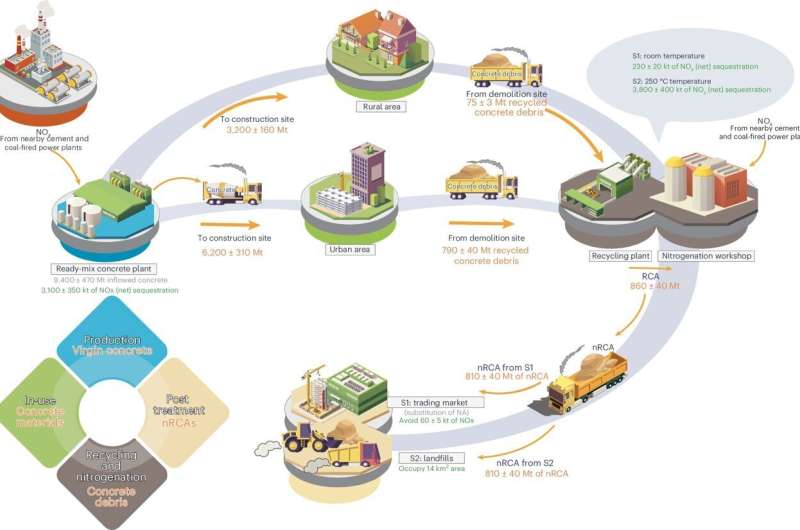
Adding nitrogen to concrete could significantly reduce global levels of potentially harmful nitrogen oxides (NOx) created by the construction industry in developing towns and cities, a new study reveals.
Researchers believe that concrete nitrogenation could contribute to a reduction in NOx emissions by 3.4–6.9 megatonnes (Mt)—representing 6–13% of industry-related emissions in 2021.
By 2050 the process could reduce NOx by a total of 131–384 Mt. It could represent the equivalent to 75–260 years potentially lost to premature death and reduced quality of life, estimated in terms of disability-adjusted life years (DALY).
NOx are highly reactive toxic air pollutants which can contribute to acid rain, ozone layer depletion and pose significant health threats—particularly in relation to respiratory disease—contributing to air pollution-related mortality.
Publishing their findings today in Nature Cities, an international group of researchers note that commercializing nitrogenation is likely to provide better economic and environmental prospects than similar processes relating to carbon dioxide (CO2).
Co-author Dr. Yuli Shan, from the University of Birmingham, commented, “Cities around the world, particularly those in the global south, are experiencing extensive urban renewal, expansion, and modernization—all inevitably creating atmospheric pollution.
“Between 1970 and 2018, global NOx emissions nearly doubled from 70 Mt to 120 Mt. Addressing and managing these emissions is crucial for enhancing urban health, fostering sustainable industrial growth, and ensuring environmental well-being.”
The first author, Ms. Ning Zhang from the Leibniz Institute of Ecological Urban & Regional Development added, “There is significant potential for concrete in capturing NOx. Applying this technology holds promise for rapidly urbanizing and emerging industrial regions, as it can generate substantial economic value and curtail industrial NOx pollution in these areas.
“The proposed nitrogenated concrete material presents a promising integrated solution for mitigating air pollution and managing construction waste in industrialized regions.”
The researchers note that China, Europe, and the United States are key players with the greatest capacity to contribute in this area—representing a mix of emerging and established industrial nations promoting circular economies and addressing atmospheric environmental concerns.
They also recommend setting up an emissions trading system like the one already created for CO2—creating a more precise and widely accepted quantification of the advantages associated with NOx sequestration.
Although significant environmental and economic benefits are possible, practical application of the processes faces challenges related to transporting large volumes of materials and gases. The experts recommend using established industrial and commercial concrete carbonation systems to help optimize the logistics network and enhance feasibility of concrete nitrogenation.
More information:
Ning Zhang et al, Contribution of concrete nitrogenation to global NOx uptake, Nature Cities (2024). DOI: 10.1038/s44284-024-00084-y
University of Birmingham
Concrete-nitrogen mix may provide major health and environment benefits (2024, June 14)
retrieved 14 June 2024
from https://techxplore.com/news/2024-06-concrete-nitrogen-major-health-environment.html
part may be reproduced without the written permission. The content is provided for information purposes only.

Adding nitrogen to concrete could significantly reduce global levels of potentially harmful nitrogen oxides (NOx) created by the construction industry in developing towns and cities, a new study reveals.
Researchers believe that concrete nitrogenation could contribute to a reduction in NOx emissions by 3.4–6.9 megatonnes (Mt)—representing 6–13% of industry-related emissions in 2021.
By 2050 the process could reduce NOx by a total of 131–384 Mt. It could represent the equivalent to 75–260 years potentially lost to premature death and reduced quality of life, estimated in terms of disability-adjusted life years (DALY).
NOx are highly reactive toxic air pollutants which can contribute to acid rain, ozone layer depletion and pose significant health threats—particularly in relation to respiratory disease—contributing to air pollution-related mortality.
Publishing their findings today in Nature Cities, an international group of researchers note that commercializing nitrogenation is likely to provide better economic and environmental prospects than similar processes relating to carbon dioxide (CO2).
Co-author Dr. Yuli Shan, from the University of Birmingham, commented, “Cities around the world, particularly those in the global south, are experiencing extensive urban renewal, expansion, and modernization—all inevitably creating atmospheric pollution.
“Between 1970 and 2018, global NOx emissions nearly doubled from 70 Mt to 120 Mt. Addressing and managing these emissions is crucial for enhancing urban health, fostering sustainable industrial growth, and ensuring environmental well-being.”
The first author, Ms. Ning Zhang from the Leibniz Institute of Ecological Urban & Regional Development added, “There is significant potential for concrete in capturing NOx. Applying this technology holds promise for rapidly urbanizing and emerging industrial regions, as it can generate substantial economic value and curtail industrial NOx pollution in these areas.
“The proposed nitrogenated concrete material presents a promising integrated solution for mitigating air pollution and managing construction waste in industrialized regions.”
The researchers note that China, Europe, and the United States are key players with the greatest capacity to contribute in this area—representing a mix of emerging and established industrial nations promoting circular economies and addressing atmospheric environmental concerns.
They also recommend setting up an emissions trading system like the one already created for CO2—creating a more precise and widely accepted quantification of the advantages associated with NOx sequestration.
Although significant environmental and economic benefits are possible, practical application of the processes faces challenges related to transporting large volumes of materials and gases. The experts recommend using established industrial and commercial concrete carbonation systems to help optimize the logistics network and enhance feasibility of concrete nitrogenation.
More information:
Ning Zhang et al, Contribution of concrete nitrogenation to global NOx uptake, Nature Cities (2024). DOI: 10.1038/s44284-024-00084-y
University of Birmingham
Concrete-nitrogen mix may provide major health and environment benefits (2024, June 14)
retrieved 14 June 2024
from https://techxplore.com/news/2024-06-concrete-nitrogen-major-health-environment.html
part may be reproduced without the written permission. The content is provided for information purposes only.









